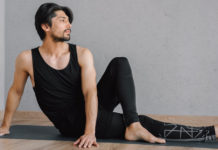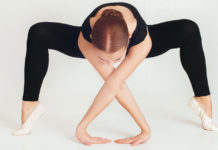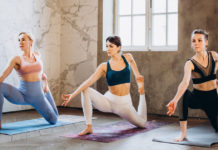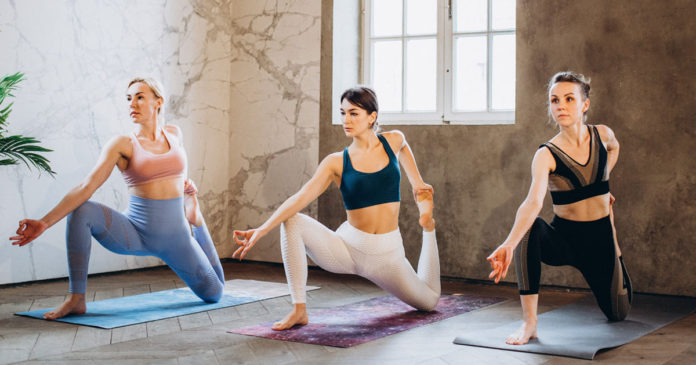Greetings from the planet of yoga, where traditional customs and contemporary living collide. We shall explore the fascinating worlds of hatha yoga vs vinyasa yoga in this part. These are two well-liked yoga styles that have become quite popular recently.
Yoga is a comprehensive discipline that treats the mind, physique, and soul. It is not merely a physical workout. Often regarded as the basis of all yoga forms, the practice of Hatha Yoga emphasizes learning fundamental poses (asanas) and breathing control techniques (pranayama). It offers a moderate method for developing strength and flexibility and gives novices a firm foundation.
Conversely, Vinyasa Yoga provides a more fluid and energetic practice method. It creates a beautiful dance-like sequence by blending breath and movement together effortlessly. Vinyasa Yoga pushes practitioners to strike a balance between elegance and power via its focus on fluid movement and inventive sequencing.
Knowing the names of different yoga styles and hatha yoga vs vinyasa yoga is not enough to comprehend them; we also need to investigate their philosophy, practices, advantages, and applications to our everyday lives. This part will provide you important insights on hatha yoga vs vinyasa yoga, regardless of how long you’ve been doing yoga for.
Now spread out your mat, inhale deeply, and come along as we explore the wonders of hatha yoga vs vinyasa yoga.
Hatha Yoga: The Traditional Path to Balance and Alignment
Within the yoga community, Hatha Yoga is a traditional form of yoga that has been practiced for many years. It provides a comprehensive approach to mental and physical health and is based on tradition. Due to its many advantages, Hatha Yoga is a well-liked option for practitioners who want to achieve harmony and balance in their life.
Hatha yoga’s capacity to enhance general fitness, flexibility, and physical strength is one of its main benefits. People may strengthen their body’s general functioning, improve their posture, and tone their muscles by practicing a sequence of hatha yoga positions. Furthermore, hatha flow’s purposeful and conscious emotions support the development of a strong mind-body connection.
Beyond its health advantages, Hatha Yoga emphasizes pranayama, or the discipline of regulating one’s breath, greatly. This hatha yoga technique facilitates relaxation and stress relief while assisting in the regulation of energy flow inside the body. People who use pranayama methods in their practice might benefit from increased emotional and mental clarity.
Examining the classic hatha yoga vs vinyasa yoga route may be quite beneficial, regardless of your level of expertise with the form or desire to improve. Its tried-and-true methods provide a means to discover harmony, balance, and inner peace in the face of life’s obstacles. Now spread out the yoga mat and let’s start this life-changing adventure!
Origins and Philosophy of Hatha Yoga:
The philosophy and historical background of Hatha Yoga are deeply rooted in the ancient yogic literature. Ancient India is the birthplace of Hatha Yoga, a kind of yoga that emphasizes body positions and breath control.
The foundations of Hatha Yoga philosophy are established in ancient scriptures including the Gheranda Samhita and the Hatha Yoga Pradipika. These books give insightful explanations of the fundamental ideas and techniques of Hatha Yoga, including instructions on bandhas (energy locks), mudras (gestures), asanas (postures), and pranayama (breath control).
Finding harmony between conflicting forces is a key component of hatha yoga vs vinyasa yoga. The ha (sun) and tha (moon) symbolize the masculine and feminine energies, respectively. To attain harmony in the body, mind, and spirit, it seeks to bring these energies together inside the individual.
We can comprehend this age-old, time-tested practice of hatha yoga vs vinyasa yoga better by delving into its history and philosophy. It challenges us to develop mindfulness, establish a connection with our true selves, and set out on a revolutionary path to holistic well-being.
Focus on Alignment and Holding Poses:
Focusing on alignment and holding postures are two essential components of hatha yoga vs vinyasa yoga practice. These guidelines are essential to guaranteeing a secure and productive yoga session.
Alignment pertains to the accurate placement of the body within every asana, or yoga pose. To prevent injuries and get the most out of your practice, it’s essential to comprehend the alignment guidelines for each posture. Through proper body alignment, we may establish equilibrium, steadiness, and encourage energy circulation throughout our whole system.
Holding postures in hatha yoga helps us become more strong, flexible, and endurance-focused practitioners, which enhances our practice. Maintaining a posture for a long time may be taxing on the body and the psyche. As we push our physical boundaries and discover how to be comfortable in uncomfortable situations, it aids in the development of attention, patience, and mindfulness.
Our physical and emotional well-being may be profoundly transformed by hatha yoga vs vinyasa yoga, and we can improve our practice by focusing on alignment and holding postures with purpose.
Incorporating Pranayama and Meditation:
Your entire experience and benefits from hatha yoga vs vinyasa yoga practice may be significantly improved by including pranayama and meditation. While meditation is about relaxing the mind and creating a feeling of inner peace, pranayama relates to the act of breath control methods.
By integrating pranayama,hatha yoga vs vinyasa yoga, physical postures (asanas), and meditation, a comprehensive approach to well-being is established. By using pranayama methods like deep belly breathing or alternate nostril breathing, you can control your breathing and improve the flow of oxygen throughout your body. This aids in lowering tension and anxiety in addition to enhancing physical endurance.
Hatha yoga vs vinyasa yoga relies heavily on meditation since it helps you develop awareness and calm the mind. You may improve your attention, emotional balance, and self-awareness by practicing meditation on a daily basis. It facilitates relaxation, improves mental clarity, and lessens mental chatter.
Hatha yoga vs vinyasa yoga pranayama and meditation may strengthen your mental, physical, and spiritual connection. Thus, throughout your practice, dedicate some time to investigating these potent methods that have been handed down through the ages for their many advantages.
Vinyasa Yoga: Flowing with Grace and Fluidity
Often called “flow yoga,” vinyasa yoga is an elegant and energetic form of yoga that smoothly combines breath and movement. This section will cover some of the most well-liked vinyasa sequences as well as the advantages of vinyasa flow.
The capacity of vinyasa yoga to simultaneously develop strength, flexibility, and awareness is among its greatest benefits. In their practice, practitioners may achieve a feeling of grace and fluidity by coordinating breath with movement.
Vinyasa flow has several physical advantages, such as stronger muscles, better cardiovascular health, and greater balance. Over time, the constant flow of motions aids in the development of stamina and endurance.
Additionally, vinyasa sequences may be customized to meet the requirements and tastes of each person. There’s a variety of possibilities from easy flows for novices to more difficult sequences for experienced practitioners. Every series usually consists of a mix of standing positions, twists, backbends, inversions, and forward folds to provide a complete, body-focused practice.
Vinyasa yoga provides a comprehensive approach to wellbeing, whether your goal is inner peace or physical fitness. Now, let’s explore the realm of graceful and fluid movement with this lovely exercise.
Origins and Philosophy of Vinyasa Yoga:
Vinyasa yoga is a well-liked kind of yoga that is performed all over the globe and has its origins in very old customs. Gaining knowledge about vinyasa’s history and philosophy might help you better understand this dynamic and fluid practice.
Vinyasa’s origins may be found in the traditional yoga scriptures and teachings. It is said to have come from the original Ashtanga Vinyasa method that Sri Krishnamacharya created at the beginning of the 20th century. This method placed a strong emphasis on breathing in unison with movement to provide a smooth transition between poses.
Vinyasa yoga’s underlying philosophy centers on the idea of integrating the mind, body, and breath. The definition of “vinyasa” as “to place in a particular way” emphasizes the significance of deliberate sequencing in this particular practice. Because each movement is carefully synchronized with the breath, practitioners may develop presence and mindfulness while practicing on their mats.
Vinyasa practice heavily relies on yoga sequencing. It entails carefully arranging poses to produce a harmonious flow that improves general health, flexibility, and strength. The sequences often change according to themes or objectives, giving practitioners the freedom to experiment with diverse facets of their work while keeping a steady cadence.
Including vinyasa philosophy in your yoga practice has several advantages. It builds a stronger connection between the body and the mind and promotes movement with grace and fluidity. Practitioners may feel a feeling of meditation in motion—finding quiet amid movement—by coordinating their breath with each pose.
As you begin your vinyasa practice, savor its intellectual underpinnings and long history. Savor the benefits of deliberate sequencing as you mindfully go through each pose, respecting tradition and your own development as a yogi.
Dynamic Flowing Sequences:
Vinyasa sequences are renowned for their elegance and fluidity in the yoga community. These sequences consist of a succession of breath-synchronized, well-coordinated motions that flow from one posture to the next. Understanding the technique of transitions—switching fluidly and rhythmically from one position to the next—is essential to mastering vinyasas.
Vinyasa sequences provide practitioners the chance to develop strength, flexibility, and awareness while keeping a consistent connection to their breath. Yogis create a beautiful dance between their body and breath by coordinating every movement with an inhalation or exhale.
Incorporating a feeling of flow and connectedness throughout the practice is what makes dynamic flowing sequences so beautiful. Practitioners are able to go deeper into their practice on a mental and physical level as they go through different postures because of the effortless combination of movement and breath.
Vinyasa sequences test practitioners’ ability to balance ease and effort, whether they are stepping elegantly from warrior II to extended side angles posture or downward dog to plank pose. These sequences’ continuous format promotes deep attention and concentration by pushing practitioners to remain in the present moment.
When you experiment with vinyasa transitions in your personal practice, keep in mind that the goal is to discover that sweet spot when movement becomes meditation rather than to speed through the poses. Breathe in unison with each transition, allowing the patterns to flow naturally.
Therefore, the next time you go onto your mat, accept the power of dynamic, flowing sequences. Allow them to lead you on an adventure where your movement expresses your breath, bringing your body and mind into harmony.
Breath Awareness and Finding Flow State:
Developing breath awareness is essential to entering the flow state of yoga. Practitioners may improve their capacity to achieve a state of flow by adding certain breathing exercises into vinyasas.
Breath and movement synchrony is essential in vinyasa yoga. Through deliberate attention to breath throughout each posture or transition, practitioners may develop a more profound connection between their body and mind. A more fluid and seamless practice is made possible by this increased awareness.
Ujjayi breathing, also referred to as “victorious breath,” is a method that is frequently used to improve breath awareness. This loud, deep inhale functions as an anchor for attention by regulating the airflow through the nostrils and producing a calming sound. Through the use of Ujjayi breathing, practitioners may remain in the present moment and keep a steady rhythm during vinyasas.
In vinyasa sequences, it’s easier to access the elusive flow state when conscious movement and breath awareness are included. Experiencing total absorption in the here and now and easy concentration are hallmarks of the flow experience. People often say that they are “in the zone,” which means that time seems to stop and things just happen.
Yoga practitioners may develop a strong feeling of presence and access their own special flow state by using breath awareness methods during vinyasa sequences. This not only improves performance on the physical level but also fosters mental clarity and general wellbeing.
Thus, keep your breathing in mind the next time you unfold your yoga mat. Let it lead you through every step, guiding you toward that beautiful state of flow when breath, body, and mind become one.
Hatha Yoga vs Vinyasa Yoga: Choosing the Right Practice for You
There are a number of things to take into account while selecting hatha yoga vs vinyasa yoga routine that works for you. Finding the perfect fit depends on your yoga style, fitness objectives, degree of flexibility, and mindfulness practice.
Style of yoga
First, consider your hatha yoga vs vinyasa yoga preferences. Do you prefer a stronger, more dynamic style of yoga, such as Power Yoga or Vinyasa? Or would you rather do something more leisurely and slow-moving, like Yin or Hatha yoga? Your choice will be aided by knowing which yoga style appeals to you.
fitness objectives
Next, think about your fitness objectives. Do you want to tone and strengthen your muscles? If so, Ashtanga or Bikram Yoga, which are more physically demanding, can be a good fit for you. On the other hand, techniques like Kundalini or restorative yoga may be more helpful if your main objectives are relaxation and stress reduction.
Degree of flexibility
Your degree of flexibility is still another crucial consideration. If you’ve been doing hatha yoga vs vinyasa yoga for a while or are particularly flexible, you may feel at ease attempting more difficult postures in styles like Jivamukti or Iyengar Yoga. However, beginning with a beginner-friendly form of yoga, such as Hatha or Gentle Yoga, can assist you in making incremental improvements if you are new to the practice or have limited flexibility.
mindfulness exercises
Finally, think about your mindfulness exercises. Certain forms of hatha yoga vs vinyasa yoga emphasize breathing exercises and meditation in addition to physical postures. If you value developing awareness, you may find that techniques like Yin Yoga or Kundalini Yoga provide a chance for profound reflection and relaxation.
Recall that selecting the ideal yoga practice is a personalized process that cannot be standardized. It’s important to pay attention to what your body requires and choose a style that complements your tastes, objectives, degree of flexibility, and mindfulness aspirations. Finding what suits you best on your own health journey may also be aided by trying out different approaches and enrolling in different programs.
Physical Fitness and Stamina:
There are many kinds of yoga that provide differing degrees of intensity in terms of physical fitness and endurance. Practitioners of hatha yoga vs vinyasa yoga face quite different physical challenges from one another.
The goal of Hatha yoga is to hold postures longer in order to promote greater flexibility and deeper stretching. For people who want to increase their general mobility or are just starting out, this technique is excellent. Although it may not be as rigorous in terms of strength training or cardiovascular endurance, Hatha yoga may still be a great way to work out.
Conversely, Vinyasa yoga is well-known for its fluid poses that connect movement and breath. This ever-changing style often calls for stronger and more endurance-demanding postures and transitions. Regular Vinyasa practice may assist increase cardiovascular fitness, strengthen muscles, and improve endurance overall.
It is noteworthy that hatha yoga vs vinyasa yoga offers certain advantages of its own. Combining both strength and flexibility training methods into your practice will help you develop a well-rounded fitness regimen, regardless of your goals for the practice.
Always pay attention to what your body requires and see a trained teacher before beginning a new fitness program.
Mindfulness and Meditation:
It might be difficult to find moments of calm and quiet in the fast-paced world of today. On the other hand, people may develop awareness and access the potent mind-body link by practicing yoga meditation.
Yoga meditation is a synthesis of concentrated attention, regulated breathing, and physical postures. It enables practitioners to improve their general well-being, calm their minds, and lessen tension. People who invest time in this practice might become more self-aware and acquire understanding of their ideas and feelings.
Strengthening the mind-body connection is one of the main advantages of hatha yoga vs vinyasa yoga meditation. Practitioners learn to coordinate their physical activities with their psychological state via breathwork and mindful movement. People who experience this connection are better able to tune into the demands and feelings of their body.
Additionally, hatha yoga vs vinyasa yoga promotes balance and inner tranquility. It offers a place where people may separate from outside distractions and practice mindfulness in the present. Because of this elevated level of awareness, practitioners are better able to handle pressures in their everyday lives and tackle problems with clarity.
Including mindfulness exercises into our daily routines, such as hatha yoga vs vinyasa yoga, may have a significant positive impact on our general wellbeing. Through these activities, we may cultivate a stronger mind-body connection, which will help us discover inner peace and gracefully handle life’s ups and downs.
Personal Preferences and Lifestyle:
Selecting the appropriate yoga style may have a big impact on lifestyle and personal preferences. Two well-liked forms of yoga is hatha yoga vs vinyasa yoga, both having special qualities that suit certain personality types.
Hatha yoga is renowned for its slower tempo and emphasis on maintaining positions for extended periods of time. It is appropriate for anyone who would rather exercise in a softer, more carefree manner. Hatha yoga enables practitioners to advance at their own speed in terms of strength, flexibility, and balance.
Vinyasa yoga, on the other hand, is a more fluid and alive technique that synchronizes breath and movement. It’s perfect for anyone who wants a more intense practice that works their body and mind. Vinyasa yoga improves flexibility, coordination, and awareness in addition to providing cardiovascular exercise.
Deciding you do hatha yoga vs vinyasa yoga at a studio or at home is another thing to think about. Convenience and flexibility come with practicing at home since you can adjust your practice to fit your schedule. It also enables comfort and seclusion in your own area.
Attending a yoga studio, however, has a number of benefits as well. Having other practitioners around you in a specific location fosters motivation and a feeling of community. Experienced teachers in studios are often available to provide advice, corrections, and adaptations depending on the requirements of each person.
Whether to practice vinyasa or hatha yoga and whether to practice at home or in a studio ultimately comes down to individual preferences, time constraints, support networks, and availability of resources. To create a routine that fits with your lifestyle, it’s critical to figure out which method works best for you.
Conclusion: Embracing the Path that Resonates With You
In conclusion, there is no universal approach to selecting a hatha yoga vs vinyasa yoga technique or practice; this should be kept in mind. It is more important to select a yoga practice that suits your unique requirements and tastes, regardless of whether you are more drawn to Vinyasa yoga’s fluid and dynamic movements or Hatha yoga’s disciplined and organized style.
It will be easier for you to choose your route if you are aware of the many yoga styles and practices. It’s all about trying and exploring many styles until you discover the one that really connects with you.
Yoga ultimately aims to promote spiritual development, cerebral clarity, emotional stability, and physical health. It thus doesn’t really matter which technique you prefer—Hatha, Vinyasa, or any other—what matters is that you embrace a route that feels right for your body, mind, and spirit.
So go ahead and explore the yoga world with an open heart and mind. Attend a variety of lessons, experiment with different approaches, and pay attention to your gut. Yoga should be practiced in a manner that elicits feelings of self-discovery, tranquility, and pleasure, without regard to correctness or incorrectness.








